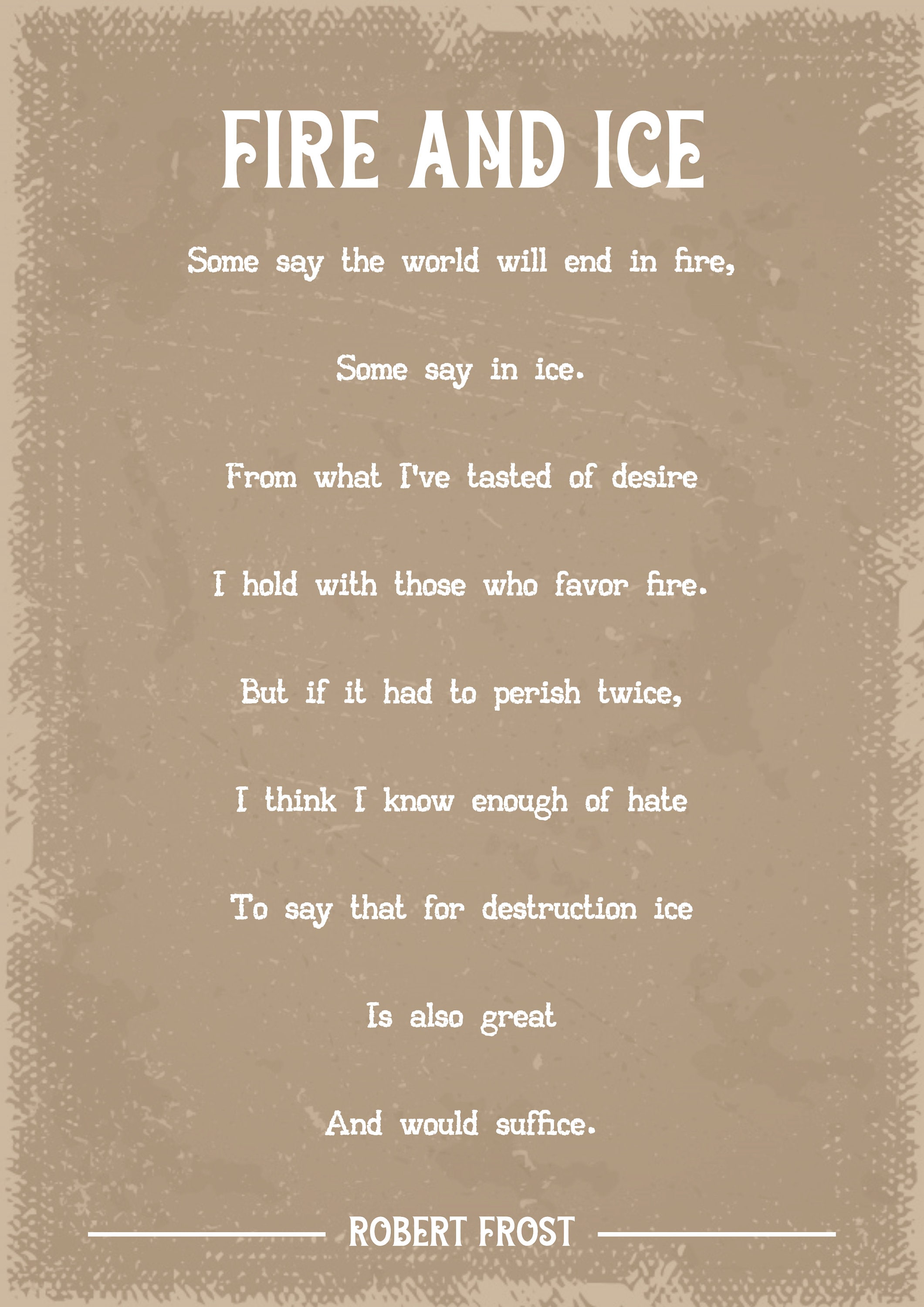
Fire and Ice: A Poetic Exploration of Desire and Destruction
Robert Frost’s iconic poem, "Fire and Ice," has captivated readers with its enigmatic depiction of desire and destruction. The poem’s haunting imagery and rhythmic cadences have made it a timeless masterpiece, inspiring countless interpretations and literary discussions.
The Poem:
Some say the world will end in fire,
Some say in ice.
From what I’ve tasted of desire
I hold with those who favor fire.
But if it had to perish twice,
I think I know enough of hate
To say that for destruction ice
Is also great
And would suffice.
Meaning and Symbolism:
The poem presents a dichotomy of two elemental forces, fire and ice, as metaphors for the destructive and transformative powers that shape the world. Fire represents passionate desire, burning with intensity and leaving behind both creation and ruin. Ice, on the other hand, symbolizes cold, calculated hatred that chills the soul and obliterates without a trace.
Frost suggests that the world could succumb to either extreme. Those who favor fire believe in the transformative power of passionate desire, capable of both destruction and renewal. Those who favor ice recognize the destructive potential of hatred, its ability to extinguish all that is good and beautiful.
Ultimately, Frost concludes that both fire and ice possess the capacity for destruction. While fire may leave behind a semblance of life, ice erases everything in its wake. The choice between the two is merely a question of which form of destruction is preferred.
Suitable Writing Styles:
The Fire and Ice poem by Robert Frost lends itself to a variety of writing styles, each capturing a different aspect of its meaning and symbolism.
- Lyrical Poetry: The poem’s rhythm and rhyme scheme invite lyrical adaptations that emphasize its musicality and emotional resonance.
- Narrative Poetry: The poem could be expanded into a narrative exploring the consequences of desire and hatred, depicting characters who embody these elemental forces.
- Free Verse Poetry: The poem’s themes and ideas could be conveyed in free verse, allowing for more flexibility in rhythm and structure while preserving its essence.
Poems About Fire and Ice
Desolation
In a world consumed by flame,
Desire burns with reckless might,
Leaving ashes in its wake,
A twisted dance of day and night.
But when the fire’s embers die,
Ice descends with chilling dread,
Extinguishing all that’s left,
A desolate wasteland, cold and dead.
The Torment of Choice
Fire and ice, a cruel test,
Both capable of destruction’s might,
Which shall I embrace, I’m pressed,
In this torment of choice, I fight.
The fire’s allure, a burning desire,
Promises transformation and birth,
But its aftermath, a searing pyre,
A sacrifice I fear with worth.
The ice’s grip, a frozen embrace,
Preserves nothing but my pain,
Yet its coldness offers a respite’s grace,
A refuge from life’s relentless strain.
Redemption or Annihilation?
In fire’s embrace, I burn and yearn,
A phoenix rising from ashes bright,
Or consumed by passion’s fervent burn,
A tragic tale of love’s plight.
In ice’s grasp, I’m frozen deep,
Preserved in time’s relentless flow,
A relic of a past I cannot keep,
Haunted by memories of long ago.
Fire or ice, which shall prevail,
Redemption’s path or annihilation’s grip?
This choice I make, my fate it veils,
A roll of the dice, a life in the slip.
Writing Your Own Poem
If you wish to write a poem about Fire and Ice, here are some tips:
- Read the original poem: Familiarize yourself with Frost’s imagery and symbolism to capture its essence.
- Choose your perspective: Determine whether you want to explore the themes from a human or elemental viewpoint.
- Incorporate vivid imagery: Use metaphors and similes to evoke the sensory experience of fire and ice and their destructive impact.
- Explore the emotional resonance: Examine the emotions associated with desire, hatred, and the choice between them.
- Craft a satisfying ending: Resolve the conflict or pose a thought-provoking question that leaves the reader contemplating the poem’s meaning.
Reading and Understanding Poetry
Poetry is an art form that requires active engagement and interpretation. Here are some tips for reading and understanding poems:
- Read aloud: Hear the rhythm and cadence of the poem to enhance your understanding.
- Pay attention to structure: Note the use of stanzas, lines, and rhyme schemes to identify patterns and transitions.
- Analyze imagery and symbolism: Explore the use of metaphors, similes, and other poetic devices to reveal the poet’s intent.
- Consider the context: Understand the historical or biographical context of the poem to gain insights into its themes and perspectives.
- Practice active reading: Engage with the poem by annotating, questioning, and reflecting on its meaning.
Conclusion
Robert Frost’s "Fire and Ice" is a testament to the enduring power of poetry to explore profound themes and evoke strong emotions. By exploring the destructive and transformative powers of fire and ice, Frost invites us to contemplate our own desires, fears, and the nature of our own existence.
Remember to seek inspiration from the original poem and to bring your own unique perspective when writing your own work. Respect copyright laws and credit the original author when using someone else’s work. Share your creations with the world, and let the joy of poetry ignite your imagination.
